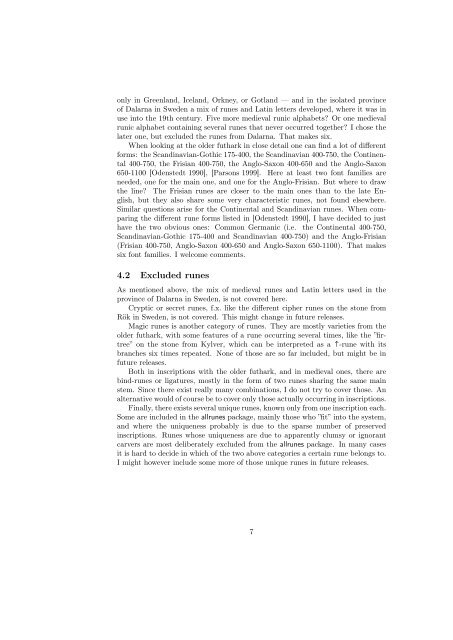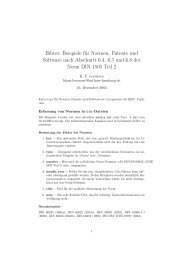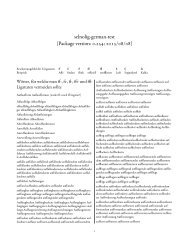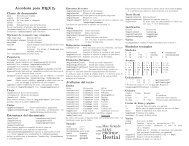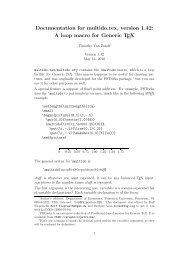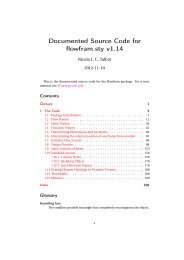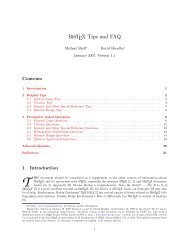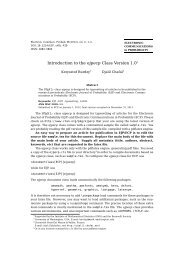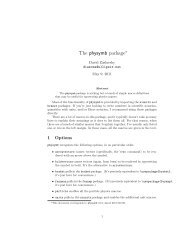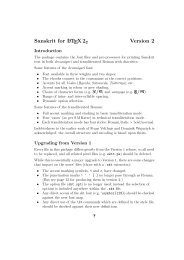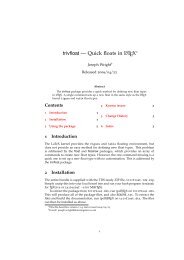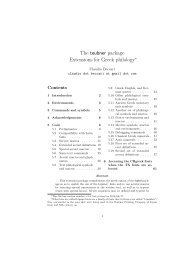The allrunes Font and Package. - CTAN
The allrunes Font and Package. - CTAN
The allrunes Font and Package. - CTAN
You also want an ePaper? Increase the reach of your titles
YUMPU automatically turns print PDFs into web optimized ePapers that Google loves.
only in Greenl<strong>and</strong>, Icel<strong>and</strong>, Orkney, or Gotl<strong>and</strong> — <strong>and</strong> in the isolated province<br />
of Dalarna in Sweden a mix of runes <strong>and</strong> Latin letters developed, where it was in<br />
use into the 19th century. Five more medieval runic alphabets? Or one medieval<br />
runic alphabet containing several runes that never occurred together? I chose the<br />
later one, but excluded the runes from Dalarna. That makes six.<br />
When looking at the older futhark in close detail one can find a lot of different<br />
forms: the Sc<strong>and</strong>inavian-Gothic 175-400, the Sc<strong>and</strong>inavian 400-750, the Continental<br />
400-750, the Frisian 400-750, the Anglo-Saxon 400-650 <strong>and</strong> the Anglo-Saxon<br />
650-1100 [Odenstedt 1990], [Parsons 1999]. Here at least two font families are<br />
needed, one for the main one, <strong>and</strong> one for the Anglo-Frisian. But where to draw<br />
the line? <strong>The</strong> Frisian runes are closer to the main ones than to the late English,<br />
but they also share some very characteristic runes, not found elsewhere.<br />
Similar questions arise for the Continental <strong>and</strong> Sc<strong>and</strong>inavian runes. When comparing<br />
the different rune forms listed in [Odenstedt 1990], I have decided to just<br />
have the two obvious ones: Common Germanic (i.e. the Continental 400-750,<br />
Sc<strong>and</strong>inavian-Gothic 175-400 <strong>and</strong> Sc<strong>and</strong>inavian 400-750) <strong>and</strong> the Anglo-Frisian<br />
(Frisian 400-750, Anglo-Saxon 400-650 <strong>and</strong> Anglo-Saxon 650-1100). That makes<br />
six font families. I welcome comments.<br />
4.2 Excluded runes<br />
As mentioned above, the mix of medieval runes <strong>and</strong> Latin letters used in the<br />
province of Dalarna in Sweden, is not covered here.<br />
Cryptic or secret runes, f.x. like the different cipher runes on the stone from<br />
Rök in Sweden, is not covered. This might change in future releases.<br />
Magic runes is another category of runes. <strong>The</strong>y are mostly varieties from the<br />
older futhark, with some features of a rune occurring several times, like the ”firtree”<br />
on the stone from Kylver, which can be interpreted as a t-rune with its<br />
branches six times repeated. None of those are so far included, but might be in<br />
future releases.<br />
Both in inscriptions with the older futhark, <strong>and</strong> in medieval ones, there are<br />
bind-runes or ligatures, mostly in the form of two runes sharing the same main<br />
stem. Since there exist really many combinations, I do not try to cover those. An<br />
alternative would of course be to cover only those actually occurring in inscriptions.<br />
Finally, there exists several unique runes, known only from one inscription each.<br />
Some are included in the <strong>allrunes</strong> package, mainly those who ”fit” into the system,<br />
<strong>and</strong> where the uniqueness probably is due to the sparse number of preserved<br />
inscriptions. Runes whose uniqueness are due to apparently clumsy or ignorant<br />
carvers are most deliberately excluded from the <strong>allrunes</strong> package. In many cases<br />
it is hard to decide in which of the two above categories a certain rune belongs to.<br />
I might however include some more of those unique runes in future releases.<br />
7


